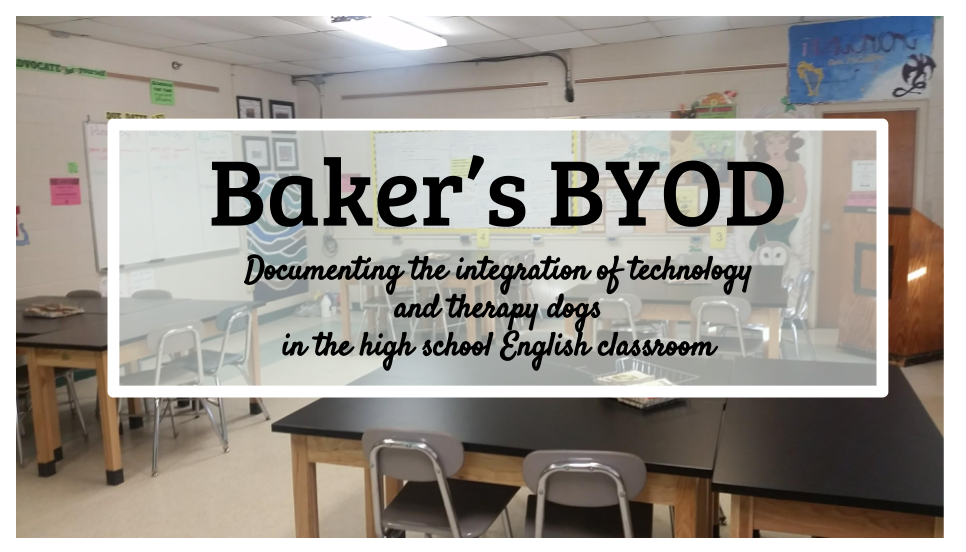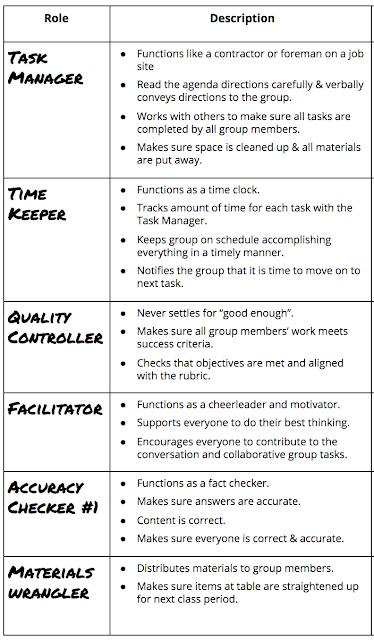Protocols & Procedures
This protocol for a class routine is designed to promote student accountability and efficacy, shifting the role of the teacher from the “sage on the stage” who is tethered to the front board to the “architect of learning” who creates structure for learning to occur and the “guide on the side” who facilitates student learning by circulating through the room as students work. While similar in design to a station-based model, students do not move from their seats, but rather complete tasks listed on the agenda in a set amount of time.
Set-up Quick Steps:
- Set up the room.
- Determine the agenda and copy/paste the chosen agenda format to a new document and fill in with appropriate information.
- Print agendas and organize materials for each group.
The teacher sets up the room to create four groups of six students for a 24-student class or five groups of six in a 30-student class. Students may choose their group or the teacher may assign students to a group.
Each table configuration is identified by a number, taping a sign to the wall near the group. The agenda and group roles are printed and placed in a basket or bin on each table. Materials needed for the class period are also placed in the bin/basket.
The group roles are designed to maximize student accountability and to allow for every student to participate within a group of 6 students. If there are fewer or more than 6 students in a group, they can double up on responsibilities/roles.
The Group Agendas
There are three versions of agendas that can be customized as needed with specific directions, links, and tasks. To add additional tasks to the agendas below, simply insert a new row into the table for v.1 or a new column (then merge cells to get rid of extra spaces) in the task area for v.2 and v.3 agendas. It is recommended that you keep an ongoing document on which you compile the agenda for each day. This document can be shared with students and administrators. To see an example of a month’s worth of agendas following v.1 format click here, and to see examples of v.2 and v.3, click here.Agenda v.1 is designed with all groups completing the same tasks at the same time in a 43 minute period. Think of this as a common playlist of tasks. The class period begins with a Do Now, bell-ringer activity, then progresses through three tasks, and concludes with an exit ticket. During the class period, the teacher circulates through the room, helping students and groups as needed.
The number of tasks can be increased when following Agenda v.1, but be mindful of the decrease in time for each additional task. One way to manage tasks is to break up a big assignment or a worksheet into smaller chunks. For example, a four page packet of activities could be separated into four tasks, one page per task. This will allow students to practice pacing and makes a large assignment seem less intimidating for struggling learners.
Agenda v.2 is designed with all groups completing tasks via a rotating schedule so that the teacher can meet with each group at a designated time to check work or give a mini-lesson to the group. The class period begins with a quick Do-Now and then progresses through 4 non-sequential tasks of equal duration. The 4 tasks are completed in 8 minutes each, but can be completed in any order. Each group rotates through tasks using the provided sequence listed on the agenda. The period concludes with a 3 minute Exit Ticket.
Agenda v.3 is designed with a rotating schedule of 3 non-sequential tasks of varying duration (2 short tasks, 1 longer task). The 2-1 duration tasks are completed in two 8 minute blocks and one 16 minute block. One of the 8 minute tasks is spent meeting with the teacher. Each group rotates through tasks using the provided sequence listed on the agenda. The period concludes with a 3 minute Exit Ticket.
When following v.2 and v.3 of this group protocol, it is recommended that the number of groups be kept at four so as to maximize the amount of time the teacher visits each group. Included with the agenda templates is a version of Agendas v.2 and v.3, designed for groups of 5. If the number of groups and tasks are increased to five, then the time for each task and the time the teacher has to meet with each group is decreased from 8 minutes to 6 minutes per in a 43 minute class period. This may affect the quality of the meeting with the group, the work students are completing and may impact the type of tasks they are directed to complete in such a short time.
All Do Nows and Exit Tickets should be recorded in a student’s notebook, serving as an ongoing record of activity. The class tasks can be completed in the students’ notebooks or on teacher-provided handouts or digital files as appropriate.
To minimize the time spent by the teacher accounting for student completion of work, the Quality Controller should be recording the progress of each group member throughout the period on the provided chart located under the agenda, noting the completion of each task by each group member. Rather than collecting all papers for each group member and handing the papers to the teacher, students should keep evidence of the task completion in their notebook, which can be produced upon request.
At the end of the period, the Agenda page is turned in to the teacher. The Agenda is kept on file as documentation of student participation and behavior. The teacher can award participation points to each student based on the number of tasks completed. For example, if Biff Bifferson only completed 3 out of 5 tasks, a grade of 3 out of 5 can be recorded in the gradebook for that day’s participation. The teacher can follow up with each student and verify the authenticity and accuracy of the completion of work in a quick and efficient manner. If the student makes up the INC assignments, the teacher can easily update the gradebook.
Folks who attended FlipTech East Coast and Rewire conferences got to experience the Group Agenda Protocol first hand. Below are the slides for the session.
The Group Agenda Protocol is a method for maximizing the precious time we have in class and for promoting student efficacy and autonomy in a structured learning environment.


I LOVVVVVVVVED this presentation at ISTE! Your process was so clearly explained, and it was so interactive! You should write a book, Katie!
ReplyDelete